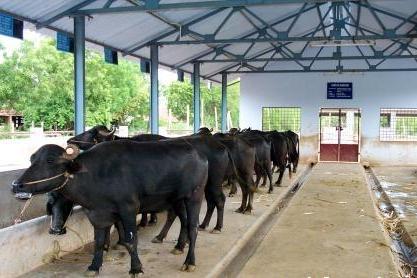Housing
Only simple housing is needed to protect the animals from direct sun. If the farmer has only one or two buffaloes, a simple shelter can be made as an extension of the existing building, utilizing the sidewalls of his building.
Only simple housing is needed to protect the animals from direct sun. If the farmer has only one or two buffaloes, a simple shelter can be made as an extension of the existing building, utilizing the sidewalls of his building.
Measurements
- Length: 3.6 m (manger 0.9, stand 1.8 m)
- Breadth: 1.3 m per animal
- Height: 3 m in the front. 1.8 m behind the wall; one side brick and cement mortar up to 0.9 m and open above.
- Pillars: Brick and cement or bamboo or any locally available timber
- Floor: Flat stone or cement concrete, slope to one side, rough finish. Atleast one foot above the ground.
- Roof: Thatch, tile or asbestos

Buffalo Housing
Housing of heifers and calves
If only two or three calves and heifers are available they may be housed along with the adult animals. If the number is more, it is better to accommodate them separately. Floor space requirement for a heifer is about 3.0 to 3.5 m2. The same for calf is about 2.5 m2. They are not tied inside the shed and are generally housed in group

Heifer Shed
Hot climate
Buffaloes may appear to be misplaced in a hot and humid environment. They have a dark skin and few sweat glands and are more dependent on water for their cooling. This is not entirely true, buffaloes protected from direct sunlight do very well even during hot and humid days, partly because their ability to loose heat through the respiratory tract. High milk production requires a high feed intake which leads to higher metabolic heat production. High yielding buffaloes thus have a disadvantage over lower yielding animals, and need more cooling facilities. The following points are guidelines to have in mind when giving advice on management.
Buffaloes may appear to be misplaced in a hot and humid environment. They have a dark skin and few sweat glands and are more dependent on water for their cooling. This is not entirely true, buffaloes protected from direct sunlight do very well even during hot and humid days, partly because their ability to loose heat through the respiratory tract. High milk production requires a high feed intake which leads to higher metabolic heat production. High yielding buffaloes thus have a disadvantage over lower yielding animals, and need more cooling facilities. The following points are guidelines to have in mind when giving advice on management.
- The feeding, watering and milking place should always give shade and protection from heavy rains, either by trees or by a roof.
- Cool water either from a clean river or served in an earthen pit, helps the animals to maintain temperature. Water trough should always be placed in the shade.
- A paddock with trees gives a very cheap and effective protection from sun. However, the trees may need to be protected from the buffaloes also.
- A shelter of a simple construction with only a roof. In hot humid climates it is better not to have walls. Walls may lead to inadequate ventilation and thereby favoring bacteria and mold growth, thus making the stable unhygienic. To protect the inside from sunshine (or heavy rain), curtains made from straw, textile or other suitable material, can be used.
- Providing the animals with a wallow. However, the wallow should be one with clean water and not far from the farm. Spending time walking in the sun to and from the wallowing costs more than it saves.
- Showering of the buffaloes with cool water for 3 minutes twice a day has proven to be an efficient way for them to get rid of excess heat
Cold climate
- A shelter should protect the animals from rain, snow and strong wind. It may be a simple construction with a roof and three walls. This system will allow the buffaloes to go outside to graze when the weather allows it. There should be a feeding area inside the shelter in case of several days with bad weather. A separate heated milking area is advisable in this case.
- Dry and clean bedding is important in cold weathers to maintain animal health.
- In case of extremely cold climate, (Caucasia and Balkan) with several months with a temperature below 0°C, a heated barn may be necessary.
Pens for calves
Calves should be kept in individual pens for the first month. The pens should be easy to keep clean, with shelter from direct sunlight, rain, snow and draught. By keeping the calves individually it is easier to check that they eat and grow properly and to detect illnesses. Also, naval suckling is avoided and spread of diseases is more difficult.
The calves should have access to fresh and clean water at all times. Preferably, the buckets for milk and water should be outside the pen, in a steady holder within easy reach for the calf. Hereby, the calves can not splash it on the bedding. Humid bedding will facilitate growth of germs and parasites. The pen should contain a holder for hay and concentrate. These holders should be placed above the ground so that the calf cannot step or defecate in them.

Calf Pen
Article Credit:http://agritech.tnau.ac.in/animal_husbandry/animhus_buffalo%20housing.html
Informative post.
ReplyDeleteBuffalo Mats Manufacturers | Cow Mats Manufacturers